As it has for the past several years, the Polynesian Cultural Center hosted its annual Moanikeala Hula Festival on February 4, 2017, in a perfect setting — under the monkeypod tree in the Hawaiian Village.
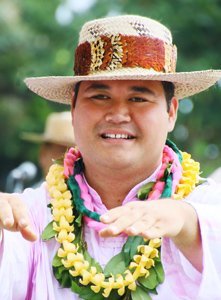
Kumu Hula Pomaika’i Krueger
PCC’s current kumu hula [or hula master teacher] Pomaika’i Krueger explained, as it has for the past 27 years, this year’s annual festival honors the legacy of the Center’s first kumu, the late Aunty Sally Moanikeala Wood Naluai who taught “many, many students” until she retired in the 1980s. (She remained active, however, as a hula consultant until she passed away in 2000.)
In addition to participating hālau or schools, the festival also included a special display about the life of Aunty Sally, as well as a Hawaiian arts and crafts fair featuring local vendors. Lono Logan, whose grandparents were among the first Hawaiian Villagers at the PCC, also put on a poi-pounding demonstration; and Hawaiian plate lunches were sold throughout the afternoon.
The Iosepa — BYU-Hawaii’s 57-foot twin-hulled Hawaiian sailing canoe, had also been pulled out of its permanent house in the village and put on display. PCC guests were invited to climb aboard, where the mast had been steeped and crew members provided information.
Krueger noted that during the years Aunty Sally taught at the PCC, “she had four students who uniki’d or graduated as kumu hula under her direction”: Cy Bridges, Keith Awai, Ellen Gay Dela Rosa — all of whom recently retired from the Center after many years of service — and Aunty Sunday Mariteragi, who worked for years at nearby Kahuku High School and established her own hālau, which she still leads. She and Dela Rosa are sisters, and Aunty Sally’s nieces.
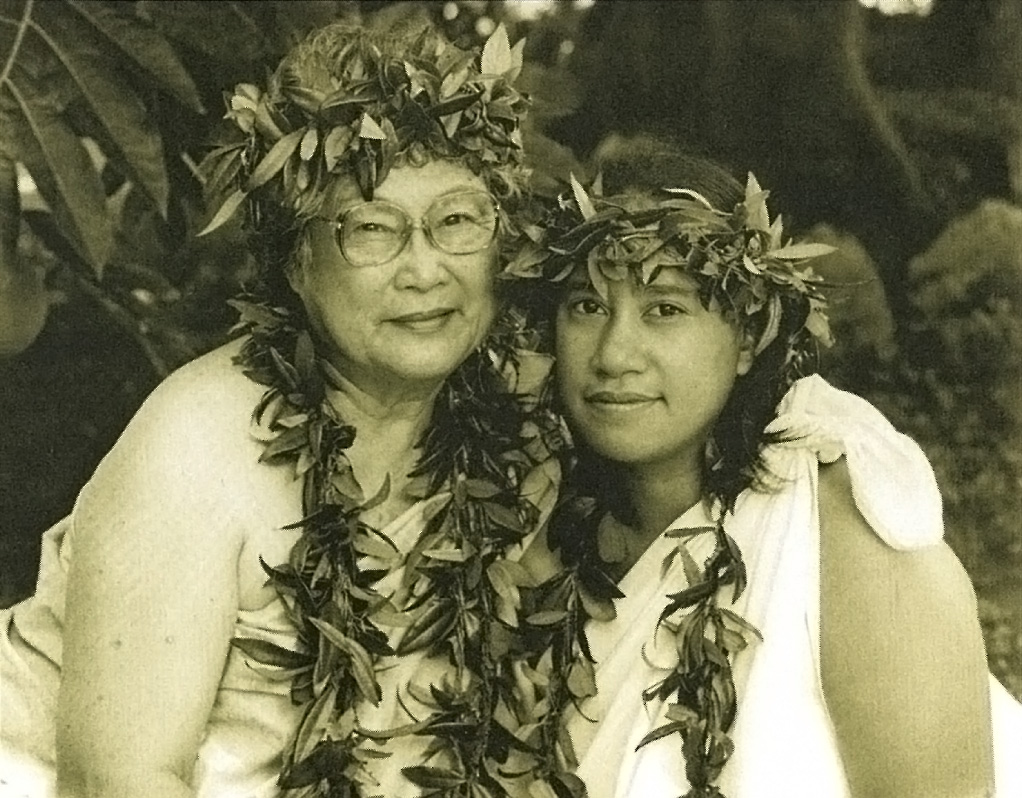
Auntie Sally and Ellen Gay
“Uncle Keith told me they were very lucky because they weren’t trained in a hālau as most dancers are; they were trained here at work,” Krueger continued. “They were also very fortunate to see their hula master dance solo at the PCC many, many times.”
Krueger then introduced his Kamaluwehiokapalai hālau from Tokyo and Guma, Japan — the first group to perform. Other participating hālau included:
- Puanani Aloha, from Nagoya, Japan, led by Yuko Kawamoto under the direction of Dela Rosa. “They are very excited to perform here,”Krueger said. “They have performed in the Moanikeala Festival each year for the past five years.”
- Hālau Hula Kula Ki’eki’e o ‘Aiea from Aiea High School (Oahu), under the direction of Jessica Nāhale and Melanie Kauvaka, the latter a PCC alumna. “This is their first time at the festival,” Krueger said.
- Ka Hula O Kealamailani from Oahu under kumu hula TeHani Gonzado performed in the kahiko or ancient style. Gonzado, who won the 2000 Miss Aloha Hula title that year at the Merrie Monarch Festival in Hilo, has had a stellar hula career.
Following their numbers, Krueger pointed out hula kahiko, dancers enter and exit the stage dancing. “The Hawaiian thinking is that the area where we dance is sacred,” he said. “This is where these songs and chants have been passed down to us; they are our history and our identity. This is the space where we share those things, so we just don’t walk onto it.”
He also pointed out that the stage decorations, though simple, were symbolic: They included a kukui tree, which “in Hawaiian means light. It represents what Aunty Sally taught all of us”; and two kinds of ferns — kupukupu, “which means to grow, and laua’e — the traveling fern. In other words, they represent the ‘light’ Aunty Sally gave to the many students who worked here at the Polynesian Cultural Center that continues to sprout, grow and travel around the world.”
“To become a kumu hula is a long and difficult task,” he continued. “Everything that I stand on is from Aunty Sally’s foundation. I never had the opportunity to meet her, but I studied under her students, who were also kumu hula here at the Polynesian Cultural Center.”
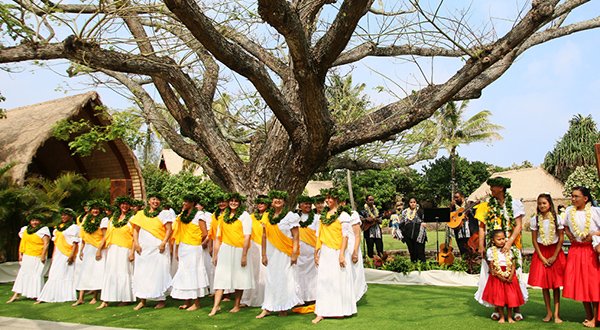
Hālau Hula O Kekela
Hālau Hula O Kekela from Laie, led by kumu hula Kela Miller. She explained she started her hālau 26 years ago “with my own grandchildren, and since then our hālau has grown. We are always happy to be at this wonderful occasion to honor a beautiful, wonderful woman. As one of the first dancers here in October 1963, we were taught by her to dance so we could perpetuate the hula.”
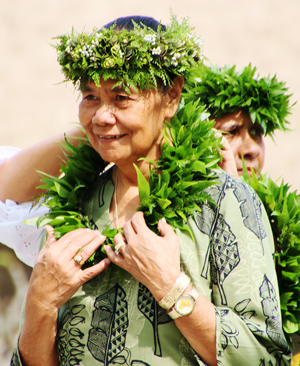
Aunty Donna Fernandez
- “I come from a long line of kumu hula,” Miller continued “One of them was my great-grandmother, Tutu Luika Pele Ka’i’o: She wrote one of the songs I’ve taught to all of my students, who all come from around here.”
- Before her group performed, Miller also honored Aunty Donna Fernandez, a former member of her hālau who now lives in Arizona. “She just became a kumu hula, and has a hālau there.” She also presented leis to Kaipo Manoa, the Hawaiian Village “chief,” her nephew, Pōmaika’i Krueger, and one to Lehua Kalili, who used to dance at the PCC but now lives in Georgia. “Whenever you come, you always bring a ho’okupu [offering],” Miller said.
Next, several of the PCC Hawaiian Villagers shared their talents with both music and hula. They were followed by several groups all from Japan:
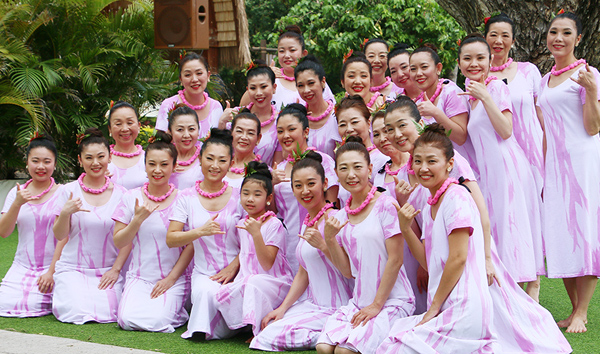
The Kageyama Hula, led by Noriko Kageyama
- The Kageyama Hula, led by Noriko Kageyama; Hula Hālau O Waipuilani, led by Yukiko Lehua Nani Abe; and Santa Hula School, directed by Koko Jitosho.
- Hu’i Park Hula Studio in Honolulu, which has been participating in the Moanikeala Festival since 1994, is now under kumu hula Kepo’omaikalani Park. “Her mother worked closely with Aunty Sally,” Krueger said. “We’re grateful to have them join us again this year.”
- And Nāpuananionāpalionāko’olau of Laie, led by kumu hula Aunty Sunday Mariteragi, who championed the concept of the festival almost three decades ago, and whose hālau still practices at the PCC so that guests can also see this aspect of Hawaiian culture.
At the end of the festival, all the kumu and dancers performed Moanikeala together to a song written in Aunty Sally’s honor.
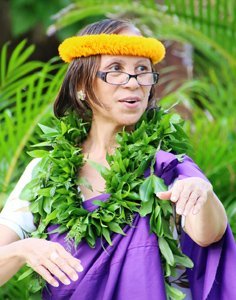
Aunty Sunday Mariteragi
Story and images by Mike Foley

Mike Foley, who has worked off-and-on at the Polynesian Cultural Center since 1968, has been a full-time freelance writer and digital media specialist since 2002, and had a long career in marketing communications and PR before that. He learned to speak fluent Samoan as a Mormon missionary before moving to Laie in 1967 — still does, and he has traveled extensively over the years throughout Polynesia and other Pacific islands. Foley is mostly retired now, but continues to contribute to various PCC and other media.

Recent Comments